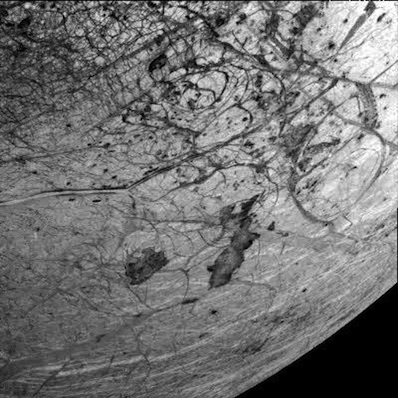
Scientists say lakes could raise odds for life on Europa
STEPHEN CLARK
SPACEFLIGHT NOW
Posted: 17 November 2011


The discovery of a reservoir of liquid water embedded in the icy crust of Jupiter's moon Europa could increase the chances for life in oceans deep beneath sheets of ice blanketing its surface, scientists said Wednesday.

NASA's Galileo spacecraft in 1997 captured this image of Thera and Thrace Macula, believed to be two relatively shallow lakes covered in floating ice. Credit: NASA/JPL
Using data from NASA's Galileo probe, researchers created a model that could explain the formation of at two relatively dark, bumpy features in Europa's surface.
Called chaos terrains, the features resemble geologic activity observed on Earth's ice shelves and under glaciers covering volcanoes, according to NASA. The researchers' model postulates the features are actually subsurface lakes that serve as conduits between Europa's outer crust and oceans deeper below.
One of the lakes could contain as much water as all of the North American Great Lakes, NASA said.
The research is presented in a paper published in the journal Nature.
"One opinion in the scientific community has been if the ice shell is thick, that's bad for biology. That might mean the surface isn't communicating with the underlying ocean," said Britney Schmidt, lead author of the paper and postdoctoral fellow at the Institute for Geophysics at the University of Texas at Austin. "Now, we see evidence that it's a thick ice shell that can mix vigorously and new evidence for giant shallow lakes. That could make Europa and its ocean more habitable."
The Galileo mission collected evidence of a global salt water ocean underneath Europa's fractured ice sheets, but most scientists believe it lies under tens of miles of ice, possibly out of the reach of the nutrients necessary for life.
The types of lakes scientists revealed Wednesday are several miles below the surface of Europa.
But the lake described in Nature is covered with floating ice shelves that might be collapsing in on themselves, restoring the subsurface ocean with nutrients, according to scientists.

Credit: Britney Schmidt/Dead Pixel VFX/Univ. of Texas at Austin.
"The data opens up some compelling possibilities," said Mary Voytek, director of NASA's astrobiology program. "However, scientists worldwide will want to take a close look at this analysis and review the data before we can fully appreciate the implication of these results."
The features studied by Schmidt's team are named Thrace and Thera Macula.
"This new understanding of processes on Europa would not have been possible without the foundation of the last 20 years of observations over Earth's ice sheets and floating ice shelves," said Don Blankenship, a co-author and senior research scientist at the Institute for Geophysics.
Scientists say the only way to verify the existence of such shallow lakes on Europa may be to send a spacecraft to orbit the moon and peer beneath the surface with a powerful radar.
A probe to Europa was proposed in a partnership between NASA and the European Space Agency for a robotic flagship mission to the outer planets. It ranked as the second highest priority in planetary science in the National Research Council's decadal survey released earlier this year.
|



